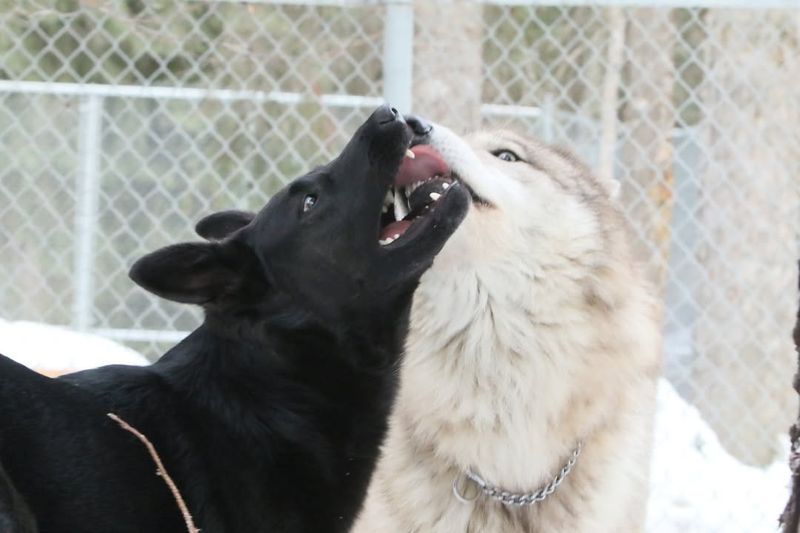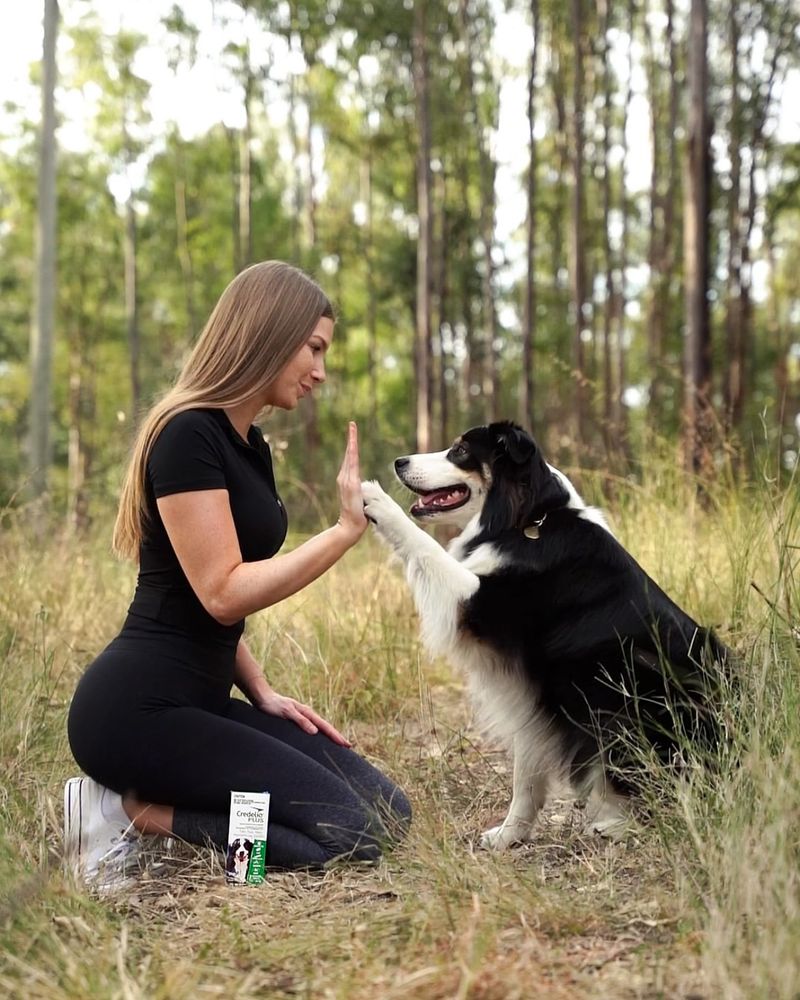Discover the truth behind some of the most common misconceptions about our furry friends.
Dogs, often considered man’s best friend, are surrounded by myths and misunderstandings that can affect their care, training, and well-being.
Let’s explore and debunk these misconceptions to provide a clearer understanding of our canine companions.
1. Dogs See In Black And White

Many people believe that dogs see only in black and white, but this is not entirely accurate. Dogs do see colors, though not as vividly as humans. Their vision is similar to a person with red-green color blindness, meaning they can perceive blues and yellows but may have trouble distinguishing reds and greens. This misunderstanding stems from early scientific studies that underestimated canine vision.
While dogs rely more on their sense of smell and hearing, their ability to see colors is still significant. Knowing this can help in selecting toys and training tools that are more visually appealing to them.
Understanding that dogs see in a limited range of colors can enhance their enjoyment and engagement with their environment. It highlights the importance of choosing the right colors when designing pet products or creating stimulating spaces for them.
2. A Wagging Tail Means A Happy Dog

It’s a common belief that a wagging tail always signifies a happy dog, but this is not the case. Tail wagging can indicate a range of emotions, including excitement, anxiety, or even aggression. The context and position of the tail are crucial for interpreting the dog’s mood.
Observing the tail’s height, speed, and direction can provide insights into what the dog is feeling. A high, fast wagging tail might indicate excitement or dominance, while a low, slow wag may suggest uncertainty or submission.
By paying attention to the nuances of a dog’s tail wagging, owners can better understand their pet’s emotional state, allowing for more effective communication and interaction. This awareness can prevent misunderstandings and improve the relationship between humans and their canine friends.
3. Dogs Eat Grass When They’re Sick

The idea that dogs eat grass solely because they’re feeling unwell is widespread. However, research shows that dogs may eat grass for various reasons, including boredom, dietary deficiency, or simply because they like the taste. While some dogs may eat grass when experiencing stomach discomfort, it is not a definitive sign of illness.
Many healthy dogs consume grass regularly without any adverse effects. This behavior is often a normal part of their exploration and interaction with the environment. Understanding that grass-eating is not always a cause for concern can help dog owners feel more at ease.
If a dog frequently eats grass and shows signs of distress, consulting a veterinarian is advisable. Otherwise, it’s usually a harmless habit that doesn’t require intervention.
4. Dogs Are Always Happy To See Their Owners

The assumption that dogs are always joyful when their owners return home is not always true. While many dogs do express excitement, others may show indifference or even anxiety. Several factors, like the dog’s personality, past experiences, and attachment level, influence their reaction.
A dog that’s been left alone for an extended period might exhibit anxiety rather than happiness upon reunion. Conversely, a well-adjusted dog may greet its owner calmly, reflecting comfort and confidence in the relationship. Recognizing that not every dog displays exuberant energy when reuniting with its owner can help manage expectations.
Observing the dog’s body language and behavior over time will provide a more accurate understanding of their emotional state, enhancing the bond between owner and pet.
5. Dogs Need Baths Weekly

The notion that dogs require weekly baths is a misconception that can lead to skin issues. Frequent bathing can strip a dog’s skin and coat of essential oils, causing dryness and irritation. The bathing frequency should vary based on the breed, coat type, and individual needs.
For most dogs, a bath every 3-4 weeks is sufficient to maintain cleanliness without affecting their skin’s health. Some breeds with natural oils may need even less frequent bathing. It’s essential to use a dog-specific shampoo to minimize potential skin reactions. Understanding the right bathing schedule can help in maintaining a dog’s skin and coat health.
It also ensures that grooming becomes a positive experience rather than a stressful activity. Consulting with a groomer or veterinarian can provide guidance tailored to the specific needs of each dog.
6. All Dogs Love To Play Fetch

The belief that all dogs enjoy playing fetch is not universally true. While many dogs love the game, some may show little interest in chasing a ball or stick. A dog’s preference for fetch can depend on factors like breed, personality, and past experiences.
Certain breeds, such as retrievers, are more inclined to enjoy fetch due to their instincts and training. However, dogs that lack these traits may find the game unappealing. It’s crucial for owners to observe their dog’s reactions and preferences, offering different activities to suit their interests.
Acknowledging that not every dog enjoys fetch can lead to more fulfilling playtime experiences. By exploring various games and activities, owners can find what truly engages their dog, fostering a stronger bond and a happier, more active lifestyle.
7. All Dogs Bark Excessively

The stereotype that all dogs bark excessively is misleading. While barking is a natural form of communication for dogs, not all breeds or individual dogs are prone to excessive barking. Factors such as breed, environment, training, and personality play significant roles in a dog’s barking behavior.
Some breeds may bark more due to their hunting backgrounds. In contrast, breeds like Basenjis are known for being relatively quiet. Training and socialization can also influence a dog’s tendency to bark, helping them learn when it’s appropriate to vocalize. Understanding that barking behavior varies among dogs can assist owners in managing noise levels and maintaining a peaceful living environment.
By focusing on training and recognizing the factors that contribute to barking, owners can foster a harmonious coexistence with their furry companions.
8. Large Dogs Are More Aggressive

The idea that large dogs are inherently more aggressive than smaller breeds is a misconception rooted in fear and misunderstanding. In reality, a dog’s temperament depends on factors like breeding, socialization, and individual personality, rather than size alone.
Many large breeds, such as Newfoundlands and Golden Retrievers, are known for their gentle and friendly nature. Conversely, some smaller breeds may exhibit more aggressive tendencies due to their protective instincts or anxiety. Proper training and socialization are key to ensuring any dog, regardless of size, behaves appropriately.
Challenging the stereotype of large dogs being aggressive can lead to more informed decisions when choosing a pet. Understanding that size is not a predictor of behavior helps in appreciating the unique traits of each breed, fostering more positive interactions and relationships between humans and their canine companions.
9. Dogs Hate Cats

The notion that dogs and cats are natural enemies is a stereotype perpetuated by media and popular culture. In reality, many dogs and cats coexist peacefully and even form strong bonds. The key to fostering a harmonious relationship lies in proper introductions and understanding each animal’s personality.
Dogs with a high prey drive may initially perceive cats as a threat or chase target. However, with careful training and supervised interactions, they can learn to live peacefully with feline companions. Cats, too, can adapt to sharing their space with dogs, especially if introduced at a young age.
Overcoming the myth that dogs inherently dislike cats can lead to more successful multi-pet households. By focusing on gradual introductions and respecting each pet’s comfort levels, owners can create an environment where both species thrive together, enriching the lives of all involved.
10. Dogs Can’t Feel Guilt

The expression of guilt in dogs is often debated among pet owners and experts. While dogs may appear guilty, displaying behavior such as cowering or avoiding eye contact, it’s not clear if they experience guilt in the same way humans do.
These behaviors are more likely a response to the owner’s tone or body language rather than an understanding of having done something wrong. Dogs are highly attuned to human emotions and may react submissively to cues indicating displeasure or anger.
Acknowledging that a dog’s “guilty look” is not necessarily an expression of guilt can alter how owners respond to such situations. By focusing on positive reinforcement and clear communication, owners can guide their pets’ behavior without misinterpreting their actions, leading to a more effective and compassionate training approach.
11. Dogs And Wolves Are the Same

While dogs and wolves share common ancestry, they are not the same. Thousands of years of domestication have created significant differences in behavior, appearance, and genetics between the two species.
Dogs have evolved to live alongside humans, developing traits that make them suitable companions, such as sociability and adaptability. Wolves, on the other hand, retain their wild instincts and require a vastly different environment and social structure to thrive.
Recognizing that they are not the same can prevent misconceptions and promote more informed decisions about pet ownership and care, ensuring that dogs are loved and understood as the distinct species they are.
12. Dogs Need A Lot Of Space

The idea that all dogs require large amounts of space to be happy is a misconception that often deters potential pet owners living in urban environments. While some large breeds may benefit from more room, many dogs thrive in smaller settings with adequate exercise and mental stimulation. Dogs adapt well to different living conditions as long as their needs are met.
Regular walks, playtime, and enrichment activities can provide the necessary physical and mental outlets, even in limited spaces. Choosing a breed compatible with one’s lifestyle and surroundings is key to a successful pet-owner relationship.
By challenging the belief that dogs need vast spaces to be content, more people can consider adopting a dog, regardless of their living situation. With proper care and attention, dogs can lead fulfilling lives in both sprawling homes and cozy apartments.
13. Dogs Shouldn’t Sleep On The Bed

The belief that dogs should not sleep on their owner’s bed is rooted in concerns about hygiene, dominance, and behavior. However, research and experience show that allowing dogs to sleep on the bed can have numerous benefits for both pets and their owners. Sharing a sleeping space can strengthen the bond between a dog and its owner, providing comfort and security.
For many people, having their dog close by during the night enhances relaxation and reduces stress. It’s essential, though, to establish boundaries and ensure that the arrangement fits both the human and the dog’s needs. Understanding that sharing a bed is a personal choice that can enhance the human-canine relationship helps in making decisions that suit individual preferences and lifestyles.
By considering both benefits and potential downsides, owners can find a sleeping arrangement that fosters harmony and well-being for all involved.
14. Puppies Shouldn’t Be Socialized Until Vaccinated

The misconception that puppies should not be socialized until they are fully vaccinated can delay crucial development. Early socialization is vital for puppies to develop into well-adjusted dogs, and waiting too long can lead to behavioral issues.
While it’s important to protect puppies from diseases, controlled socialization in safe environments is beneficial. Puppy classes or playdates with vaccinated dogs can provide positive experiences that foster confidence and sociability.
Balancing health precautions with social exposure is key. Recognizing the importance of early socialization helps owners prepare their puppies for a lifetime of positive interactions.
By responsibly introducing puppies to various experiences and environments, owners can nurture well-behaved, adaptable dogs that thrive in diverse situations.
15. Small Dogs Are Easier To Manage

The belief that small dogs are easier to manage than larger breeds is a misconception that often leads to unmet expectations. While smaller dogs may require less space, they can be just as demanding in terms of training, exercise, and attention.
Small dogs often have big personalities and can exhibit behavioral issues such as excessive barking or aggression if not properly managed. They may also require specialized care, such as grooming or dental maintenance. Owners should be prepared to invest time and effort, regardless of the dog’s size.
Understanding that small dogs have unique needs and challenges can lead to more informed pet ownership. By recognizing the demands of small dog care, owners can ensure they provide environments where their pets can thrive, fostering happier and healthier relationships.
16. Dogs Can’t Eat Human Food

The belief that dogs cannot eat any human food is an oversimplification. While some human foods are indeed harmful to dogs, many others can be healthy and beneficial when offered in moderation.
Fruits and vegetables like carrots, apples, and blueberries can provide essential nutrients and serve as tasty treats. However, foods like chocolate, grapes, and onions should be strictly avoided. It’s important for dog owners to educate themselves on safe food options and consult with a veterinarian when in doubt.
By understanding which human foods are safe, owners can enhance their dog’s diet with variety and nutrition. This awareness helps in making informed decisions about treats and supplements, contributing to a balanced and healthy diet for their canine companions.
17. Dogs Don’t Understand Time

The idea that dogs do not understand time is a misconception that overlooks their ability to recognize patterns and routines. While dogs may not perceive time in the same way humans do, they are capable of anticipating events based on previous experiences.
Dogs can learn the timing of daily activities, such as meals or walks, and may even show signs of excitement or restlessness when a routine is disrupted. Their internal clocks are influenced by environmental cues, like changes in light or their owner’s behavior.
Acknowledging that dogs have a sense of time helps in creating consistent routines that provide comfort and stability.
18. You Can’t Teach An Old Dog New Tricks

The saying “You can’t teach an old dog new tricks” is a misconception that underestimates the learning potential of older dogs. While young dogs may learn more quickly, older dogs are also capable of learning with patience and consistency.
Training an older dog can present unique challenges, such as ingrained habits or physical limitations. However, the bond between an older dog and its owner can facilitate effective learning. Adaptations in training methods, like shorter sessions or positive reinforcement, can yield successful results.
By debunking the myth that older dogs cannot learn, owners can continue to engage their senior pets in enriching activities. This not only enhances the dog’s mental stimulation but also strengthens the relationship, providing quality experiences throughout their lives.

